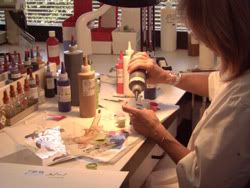Disney Restoration
THE ART OF RESTORING DISNEY
How Cels and other unique Disney art are brought back to life
It looks like a cross between an artist's studio and a scientist's lair: dozens of tiny bottles of multihued paint share table space with an iron, several blenders, color meters, and a microscope. And this is indeed a place where art and science meet: All this equipment is being employed in the service of a sheet of nitrate, bearing the hand-painted image of a motley-clad lute player.

Once again, the fairest of them all -- meticulous restoration has returned this "Snow White and the Seven Dwarfs" cel to its full glory
That transparent sheet is an original hand-painted cel used in the creation of the Disney masterpiece "Sleeping Beauty," one of about 400,000 created for that film alone - each one showing a different moment in the story, and each one unique. And saving it from disintegration is the task of Ron Stark, Director of S/R Laboratories Animation Art Conservation Center. The Disney Insider visited S/R Labs, the only animation conservation laboratory in the world, to learn what goes in to preserving and restoring these unique (and highly collectible) works of art.
Ron gestures at the art hanging on the walls in the S/R hallway - lush watercolor backgrounds from "Pinocchio," oil paintings created to help visualize "Bambi," sketches of mermaids made when planning "Peter Pan," and original cels from "Fantasia" and a score of other Disney films.
"None of this was intended to last," he explains. The Walt Disney Studio focused on creating a movie, not cels and sketches for their own sake. Art was created, photographed by the animation cameras, and then tossed or sent to storage. Preliminary sketches were not done on acid-free paper, and the inks used were often prone to fading. Drawings were sometimes pasted over other drawings on the same backing board.
Over time, however, appreciation has grown for the beauty and unique nature of animation cels and other art produced by animators - like maquettes, the plaster sculptures created so animators can envision a character from every side, and the beautifully detailed paintings that form the background for the animated action. Collectors treasure them, and the Walt Disney Studio recognizes the value of these priceless pieces of its own history. Editor's Note: Not to be crass or cynical.....umm...but Disney sees a potential profit motive here, TOO, right?
Enter S/R Labs, a "search and rescue" team for animation art. Originally founded in 1978 as a volunteer project to save vanishing pieces of animation memorabilia, today S/R is private business that restores and preserves animation art of all kinds, for studios, museums, galleries, and private collectors alike. Although concept drawings, background paintings, and production paintings are subject to the same restoration techniques as conventional fine-art pieces, animation art does pose some special challenges.
"Cels are tricky to preserve," Ron explains. "The pencil outline is done on one side of the clear background sheet (nitrate for older cels, acetate for more recent ones) and the paint is done on the other, so if the cel itself breaks down there's no way to remove and preserve the art."
And Ron demonstrates just how fragile aging nitrate can become, running a thumb across a brittle edge that explodes into tiny glassy fragments. Aging nitrate can also buckle, crack, become cloudy, or turn brown, and the paint often flakes or fades. After seeing the condition of older pieces before restoration, the beauty of the restored cels can be almost startling - the colors brilliant, the details sharp, and the surface clear and flat.
To accomplish this magic takes a mix of chemistry and artistry -- the conservators use thousands of paint tones, painstakingly following the original Walt Disney Studio color keys for the era when a particular piece of art was produced. Even the pen nibs used to refresh damaged ink lines are Studio originals, provided to S/R by a former Disney staffer. Restoring a single cel or drawing may take weeks. Maquettes, made of soft plaster, almost inevitably arrive chipped and dirty, and often broken as well, to be restored to their snowy original glory.

All of the colors made at S/R Labs are mixed and matched under three different light sources in order to assure accuracy.
Although many restorations are done for the Walt Disney Studio itself, most are commissioned by private collectors who want to preserve these pieces of the Disney legacy. Ron stresses that collectors who buy pieces in good condition will find it easier and less expensive to take steps to preserve them before they are damaged, rather than restoring them after deterioration has occurred. On the other hand, pieces that are already in a deteriorated condition can sometimes present a wonderful bargain for the purchaser - refurbished with care they can realize a spectacular increase in value and beauty.
Returning to that little minstrel cel, hanging in the restoration lab, Ron says "This is it - the real painting that represents one 24th of a second that audiences actually saw onscreen in 'Sleeping Beauty.' These are the brushstrokes that created that movie. And you can hold it in your hands."
Nothing could better sum up the magic of animation art - and thanks to the efforts of the conservators of S/R Labs, it's a magic that will always be with us.
How Cels and other unique Disney art are brought back to life
It looks like a cross between an artist's studio and a scientist's lair: dozens of tiny bottles of multihued paint share table space with an iron, several blenders, color meters, and a microscope. And this is indeed a place where art and science meet: All this equipment is being employed in the service of a sheet of nitrate, bearing the hand-painted image of a motley-clad lute player.

Once again, the fairest of them all -- meticulous restoration has returned this "Snow White and the Seven Dwarfs" cel to its full glory
That transparent sheet is an original hand-painted cel used in the creation of the Disney masterpiece "Sleeping Beauty," one of about 400,000 created for that film alone - each one showing a different moment in the story, and each one unique. And saving it from disintegration is the task of Ron Stark, Director of S/R Laboratories Animation Art Conservation Center. The Disney Insider visited S/R Labs, the only animation conservation laboratory in the world, to learn what goes in to preserving and restoring these unique (and highly collectible) works of art.
Ron gestures at the art hanging on the walls in the S/R hallway - lush watercolor backgrounds from "Pinocchio," oil paintings created to help visualize "Bambi," sketches of mermaids made when planning "Peter Pan," and original cels from "Fantasia" and a score of other Disney films.
"None of this was intended to last," he explains. The Walt Disney Studio focused on creating a movie, not cels and sketches for their own sake. Art was created, photographed by the animation cameras, and then tossed or sent to storage. Preliminary sketches were not done on acid-free paper, and the inks used were often prone to fading. Drawings were sometimes pasted over other drawings on the same backing board.
Over time, however, appreciation has grown for the beauty and unique nature of animation cels and other art produced by animators - like maquettes, the plaster sculptures created so animators can envision a character from every side, and the beautifully detailed paintings that form the background for the animated action. Collectors treasure them, and the Walt Disney Studio recognizes the value of these priceless pieces of its own history. Editor's Note: Not to be crass or cynical.....umm...but Disney sees a potential profit motive here, TOO, right?
Enter S/R Labs, a "search and rescue" team for animation art. Originally founded in 1978 as a volunteer project to save vanishing pieces of animation memorabilia, today S/R is private business that restores and preserves animation art of all kinds, for studios, museums, galleries, and private collectors alike. Although concept drawings, background paintings, and production paintings are subject to the same restoration techniques as conventional fine-art pieces, animation art does pose some special challenges.
"Cels are tricky to preserve," Ron explains. "The pencil outline is done on one side of the clear background sheet (nitrate for older cels, acetate for more recent ones) and the paint is done on the other, so if the cel itself breaks down there's no way to remove and preserve the art."
And Ron demonstrates just how fragile aging nitrate can become, running a thumb across a brittle edge that explodes into tiny glassy fragments. Aging nitrate can also buckle, crack, become cloudy, or turn brown, and the paint often flakes or fades. After seeing the condition of older pieces before restoration, the beauty of the restored cels can be almost startling - the colors brilliant, the details sharp, and the surface clear and flat.
To accomplish this magic takes a mix of chemistry and artistry -- the conservators use thousands of paint tones, painstakingly following the original Walt Disney Studio color keys for the era when a particular piece of art was produced. Even the pen nibs used to refresh damaged ink lines are Studio originals, provided to S/R by a former Disney staffer. Restoring a single cel or drawing may take weeks. Maquettes, made of soft plaster, almost inevitably arrive chipped and dirty, and often broken as well, to be restored to their snowy original glory.

All of the colors made at S/R Labs are mixed and matched under three different light sources in order to assure accuracy.
Although many restorations are done for the Walt Disney Studio itself, most are commissioned by private collectors who want to preserve these pieces of the Disney legacy. Ron stresses that collectors who buy pieces in good condition will find it easier and less expensive to take steps to preserve them before they are damaged, rather than restoring them after deterioration has occurred. On the other hand, pieces that are already in a deteriorated condition can sometimes present a wonderful bargain for the purchaser - refurbished with care they can realize a spectacular increase in value and beauty.
Returning to that little minstrel cel, hanging in the restoration lab, Ron says "This is it - the real painting that represents one 24th of a second that audiences actually saw onscreen in 'Sleeping Beauty.' These are the brushstrokes that created that movie. And you can hold it in your hands."
Nothing could better sum up the magic of animation art - and thanks to the efforts of the conservators of S/R Labs, it's a magic that will always be with us.


0 Comments:
Post a Comment
<< Home